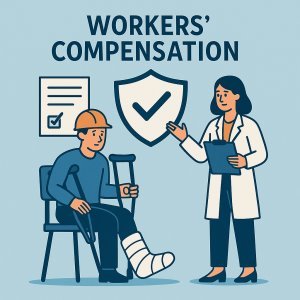
Handling High Turnover: Workers’ Comp Solutions for Georgia Security Guard Companies
September 7, 2025
Nursing Home Workers’ Compensation Insurance: The Ultimate Administrator Handbook
September 7, 2025In the senior care industry, maintaining the highest standards of safety and accountability is paramount. When an incident occurs, a thorough and systematic post-accident investigation is essential to identify root causes, implement corrective measures, and prevent future occurrences. Utilizing structured post-accident investigation templates specifically designed for senior care facilities can streamline this critical process, ensuring consistency, compliance, and comprehensive documentation.This article explores the importance of tailored investigation templates and how they contribute to enhancing operational safety and regulatory adherence in senior care environments.
Table of Contents
- Post-Accident Investigation Templates Designed for Senior Care Facilities
- Key Components of an Effective Post-Accident Investigation Template
- Best practices for Conducting Thorough Incident Investigations in Senior Care
- Recommendations for Implementing and Maintaining Post-Accident Documentation Systems
- Q&A
- The Conclusion
Post-accident Investigation Templates Designed for Senior Care Facilities
Senior care facilities require a systematic approach to understand and prevent accidents effectively. Customized investigation templates streamline the process by guiding staff through essential areas such as incident documentation, witness statements, contributing factors, and immediate corrective actions. These templates not only help capture accurate and consistent information but also support regulatory compliance and risk management efforts. By utilizing well-structured templates, facilities can enhance transparency and promote a culture of safety that protects both residents and staff.
Key Features of Effective Post-accident Investigation Templates:
- Clear sections for incident description, location, and time details
- Checklist for common causes and environmental factors
- Space for witness accounts and staff observations
- Action plan recommendations and follow-up evaluation
- Compliance with healthcare regulations and reporting standards
| Template Section | Purpose |
|---|---|
| Incident Overview | Provides summary and timeline of events |
| Environmental Assessment | Identifies hazards impacting safety |
| Witness Statements | Captures firsthand observations |
| Corrective actions | Defines steps to prevent recurrence |
Key Components of an Effective Post-Accident Investigation Template
At the core of a successful investigation template lies a detailed yet straightforward structure that allows for comprehensive data capture without overwhelming the user. essential components include a clear incident description field, precise time and location logs, and a section to identify all involved parties-residents, staff, and witnesses. Including prompts for immediate response actions taken ensures that care staff document swift measures,which can be critical in assessing the efficacy of on-site intervention. Additionally, a dedicated area for environmental factors like lighting, floor conditions, and equipment status helps identify potential systemic issues that may have contributed to the accident.
An effective template should also prioritize root cause analysis and corrective action planning. Incorporating sections with checkboxes for common risk factors-such as medication errors, mobility assistance lapses, or inadequate supervision-streamlines data collection. The inclusion of a well-structured comments box encourages detailed narrative input,fostering thorough review and accountability. Below is a streamlined example outlining these critical elements:
| Section | Purpose | Key Features |
|---|---|---|
| Incident Details | Document specifics of the accident | Time,location,people involved |
| Immediate Actions | Record initial response measures | Triage,notifications,first aid |
| Environmental Factors | Assess external contributing risks | Lighting,floor conditions,equipment |
| root Cause Analysis | Identify underlying causes | Checklists,narrative inputs |
| Corrective Actions | Outline prevention strategies | Staff training,policy updates |
Best Practices for conducting Thorough Incident Investigations in Senior Care
Effective incident investigations in senior care require a systematic and compassionate approach. Prioritize gathering detailed eyewitness accounts and relevant documentation immediately after an event. Establish a clear chain of custody for all evidence and maintain confidentiality throughout the process. Utilize structured templates to ensure consistency, covering essential aspects such as the nature of the incident, contributing factors, and potential preventative measures. Incorporating multidisciplinary insights-from nursing staff, governance, and safety experts-helps create a comprehensive understanding of the root causes.
To streamline the investigative workflow, integrate these best practices:
- Timely Reporting: Ensure incidents are reported within a specified timeframe to preserve accuracy.
- Thorough Documentation: Use standardized forms to capture factual, unbiased information.
- Collaborative Review: Involve relevant departments for diverse perspectives and accountability.
- Action-Oriented Follow-up: Develop clear corrective action plans with assigned responsibilities and deadlines.
- continuous Training: Regularly educate staff on investigation protocols and empathetic communication techniques.
| investigation Stage | Key Focus | Recommended Tools |
|---|---|---|
| Initial Response | Immediate data & witness collection | Incident report form, mobile device |
| Analysis | Root cause identification | Cause-and-effect diagrams, checklists |
| Reporting | Clear, objective documentation | Template-based reports, digital logs |
| Follow-up | Implementation & monitoring of corrective actions | Action plan trackers, staff briefings |
Recommendations for Implementing and Maintaining Post-Accident Documentation Systems
Effective implementation of post-accident documentation systems begins with comprehensive training tailored to the specific needs of senior care staff. Ensuring that team members understand the accurate completion of investigation templates fosters consistency and reliability in reporting. Utilize clear, user-amiable templates that prompt for critical details such as the time of the incident, individuals involved, environmental conditions, and immediate actions taken. Encourage a culture of transparency where staff feel agreeable reporting,thereby improving incident tracking and enabling data-driven prevention strategies.
Ongoing maintenance of these systems requires regular audits and updates based on emerging trends and regulatory requirements. Incorporate technology solutions that allow secure cloud storage and easy access for authorized personnel, enhancing data integrity and streamlining follow-up processes. The following table outlines key elements for maintaining robust documentation practices:
| Maintenance Element | Purpose | Best Practice |
|---|---|---|
| Template Reviews | Ensure forms remain relevant and comprehensive | Quarterly updates with staff input |
| Data Audits | Verify accuracy and completeness of reports | Monthly cross-check with incident logs |
| Staff Refresher Training | Maintain knowledge and compliance | Biannual workshops emphasizing best practices |
| Technology Integration | Enhance accessibility and security | Implement HIPAA-compliant digital platforms |
- Encourage feedback loops to continuously refine documentation processes.
- Assign dedicated personnel to oversee incident report management.
- Ensure alignment with state and federal regulations to avoid compliance risks.
Q&A
Q&A: Post-Accident Investigation Templates for Senior Care Facilities
Q1: What is the purpose of a post-accident investigation template in senior care facilities?
A1: A post-accident investigation template serves as a standardized tool to systematically document all relevant details following an incident involving residents or staff. it helps ensure a thorough investigation, facilitates root cause analysis, and supports compliance with regulatory requirements, ultimately aiming to improve safety and prevent future accidents.
Q2: Why are templates particularly meaningful in senior care environments?
A2: senior care facilities face unique risks due to the vulnerability of their population. Templates provide a consistent approach to documenting incidents such as falls, medication errors, or equipment failures. This consistency helps identify patterns, ensures proper communication among care teams, and supports legal and accreditation processes.
Q3: What key elements should be included in an effective post-accident investigation template?
A3: Essential elements include:
- date, time, and location of the accident
- Individuals involved and witnesses
- Detailed description of the incident
- Immediate actions taken and medical response
- Environmental factors or equipment involved
- Contributing factors and root cause analysis
- Recommendations for corrective actions
- Follow-up and monitoring plans
- Investigator’s details and signatures
Q4: how can senior care facilities benefit from using a standardized investigation template?
A4: Benefits include enhanced accuracy and completeness of reports, streamlined training for staff, improved data collection for risk management, faster identification of safety issues, and easier regulatory compliance. It also aids in legal documentation and continuous quality improvement initiatives.
Q5: Who should be responsible for completing the post-accident investigation template?
A5: Typically, a designated safety officer, nurse, or facility manager trained in incident investigation should complete the template. They should collaborate with frontline staff,witnesses,and medical personnel to gather comprehensive information.
Q6: how often should senior care facilities review and update their post-accident investigation templates?
A6: Templates should be reviewed regularly-at least annually-and after any significant regulatory changes or incidents revealing gaps in the current format. Continuous updates ensure the template remains relevant, effective, and aligned with best practices.
Q7: Can digital tools enhance the use of post-accident investigation templates?
A7: yes, digital solutions can improve accessibility, facilitate real-time reporting, automate data analytics, and integrate with broader risk management systems.Implementing electronic templates also promotes consistency and reduces errors compared to paper-based records.Q8: What role do post-accident investigation templates play in quality improvement initiatives?
A8: They provide a structured way to collect incident data that highlights systemic issues.Analysis of this data drives targeted interventions to enhance resident safety and care quality, supporting a culture of continuous improvement within the facility.
Q9: are there any regulatory standards governing post-accident investigations in senior care?
A9: Yes,agencies such as the Centers for Medicare & Medicaid Services (CMS) and state health departments often require thorough incident reporting and investigations. Using a comprehensive template helps ensure facilities meet these mandates and maintain licensure and accreditation.Q10: How should findings from post-accident investigations be communicated within the facility?
A10: Findings should be shared promptly with relevant staff and management through written reports, safety meetings, and training sessions. Obvious communication fosters accountability, informs policy changes, and promotes a proactive safety culture.
The Conclusion
implementing well-structured post-accident investigation templates is essential for senior care facilities aiming to enhance safety, ensure regulatory compliance, and foster a culture of continuous improvement. These templates provide a systematic approach to identifying root causes, facilitating transparent communication, and driving targeted corrective actions. By standardizing the investigative process, senior care organizations can minimize risks, protect their residents, and uphold the highest standards of care.Investing in comprehensive post-accident investigation tools is not only a proactive risk management strategy but also a critical component in delivering safe and compassionate care to vulnerable populations.
“This content was generated with the assistance of artificial intelligence. While we strive for accuracy, AI-generated content may not always reflect the most current information or professional advice. Users are encouraged to independently verify critical information and, where appropriate, consult with qualified professionals, lawyers, state statutes and regulations & NCCI rules & manuals before making decisions based on this content.







